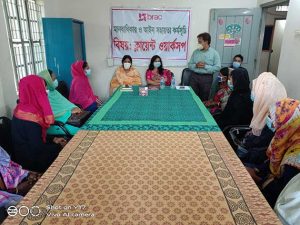Five Steps to Combat Gender-Based Violence Globally
 17 Maret 2021
17 Maret 2021

District Manager, HRLS Program, conducts a client workshop in the presence of the Upazila Nirbahi Officer, Sakhipur Upazila, Tangail. Cedit: BRAC
By Jenefa Jabbar
DHAKA, Bangladesh, Mar 16 2021 (IPS)
The 410 Legal Aid Centers that I manage in Bangladesh for BRAC’s Human Rights and Legal Aid Services received approximately 35,900 requests for assistance in 2020. Almost all of them involve gender-based violence against women and girls.
In Bangladesh, gender-based violence comes in many forms: physical abuse; husbands throwing wives out of the home in domestic disputes; husbands demanding that their wives get more dowry money from their families, and child marriage, among others. The COVID-19 pandemic has only increased the problem, as unemployment and other financial stresses have grown. BRAC documented a nearly 31 percent (8,709) increase in reported incidents of violence against women and girls in 2020 compared to the same time last year (4,566).
The problem, however, is global. The United Nations estimates that 35 percent of women worldwide have experienced either physical and/or sexual intimate partner violence or sexual violence by a non-partner (not including sexual harassment) at some point in their lives. In some nations, that number rises to 70 percent.
Through our experience, BRAC has developed an integrated five-step approach to addressing gender-based violence. This approach includes prevention, protection, partnership, rehabilitation, and monitoring. It can be replicated worldwide to defeat gender-based violence.
Prevention requires increased awareness of gender-based violence. This must be done on every scale – from global to local, justice-seeker to duty-bearer. Leaders and the public need to understand the extent and nature of the problem, the factors that influence it, and what can be done. Leaders of government, civic institutions, and religious groups need to help change the norms that have made such violence so pervasive for so long.
At BRAC, we conduct Human Rights and Legal Education (HRLE) classes with our own specially designed curriculum to inform women of their basic legal rights in cases of domestic violence, intimate partner violence, community violence, child marriage, inheritance, and trafficking, among others. In 2020, we reached out to 53,994 women and girls through these classes and provided advice and counselling to 10,492 women by phone, as the pandemic caused people to be in lockdown. In addition, BRAC organizes workshops with local community leaders on the legal rights of women and girls and the leaders’ responsibilities.

HRLS Officer provides legal assistance to a justice-seeking client in Nangalkot Upazila, Comilla. Credit: BRAC
BRAC also supports community-based women’s groups called Polli Shomaj, which are active in 54 of the nation’s 64 districts, working to stop child marriages and other forms of gender-based violence and to help women access relevant resources. In 2020, they prevented 1,091 child marriages – an increase of 196 percent over the same period in 2019.
Protection should also be pursued through proper implementation of the laws against gender- based violence. Unfortunately, the court system in Bangladesh has a backlog of 3.7 million cases, which gives perpetrators comfort that they are unlikely to be punished.
BRAC enables access to justice through alternative dispute resolution in cases that can be appropriately resolved without formal courtroom litigation. In other cases, BRAC provides court case support through its 350 enlisted panel lawyers across the country. In 2020, BRAC’s Legal Aid Centers resolved 19,854 complaints through alternative dispute resolution and filed 2,469 civil and criminal cases.
Partnership enables collaboration with government agencies and nongovernmental organizations to combat gender-based violence. Through partnerships, BRAC assists survivors of violence in getting immediate medical and shelter support and in lodging complaints at police stations. BRAC works with other service providers to assist the government in fulfilling its commitment to ensure access to justice.
Rehabilitation – both social and economic – is another vital area for mainstreaming the survivors of gender-based violence. They must be supported rather than shunned, and they must have the financial resources to survive without their abusive husbands. BRAC has succeeded in recovering a sizable amount of money for victims of gender-based violence, through alternative dispute resolution and court cases. In 2020 alone, BRAC’s Legal Aid Centers recovered $5.1 million (US) for victims. Recovery of those funds not only exacts a cost to the perpetrator; it supports the victim in her quest to establish a life free of such violence. A woman free of violence but left destitute has not received justice.
Survivors must also be re-empowered through skills training, so that they can find jobs, and through ongoing education, so that they can graduate. Re-empowerment must also be aligned with rehabilitation. The stigma of being abused must be eliminated. The norms that perpetuate gender-based violence must change.
Monitoring is essential, as it provides the latest data to increase awareness of gender-based violence and energize efforts at prevention. Monitoring should be performed by government but often falls to nongovernmental organizations – both to collect the data and provide an independent assessment. Regardless, government participation is vital.
Monitoring is needed in advance of incidents to help prevent them. Checking a girl’s birth certificate, for instance, in advance of marriage can help prevent child marriage. Monitoring is also needed to understand trends – in gender-based violence itself, criminal cases filed, judicial outcomes, and changing circumstances such as the COVID-19 pandemic.
Everyone must step forward to end gender-based violence. This five-step integrated approach marks the path. It is time for all of us to join in the march to a new day when gender-based violence is no more.
The author is Director of Human Rights and Legal Aid Services and Social Compliance at BRAC, based in Bangladesh.
The post Five Steps to Combat Gender-Based Violence Globally appeared first on Inter Press Service.
